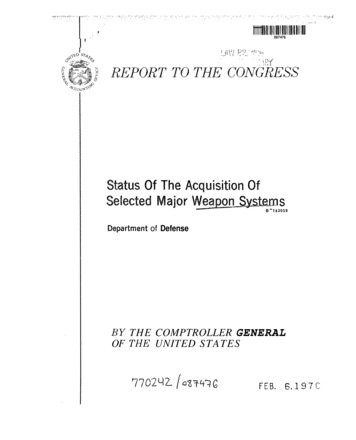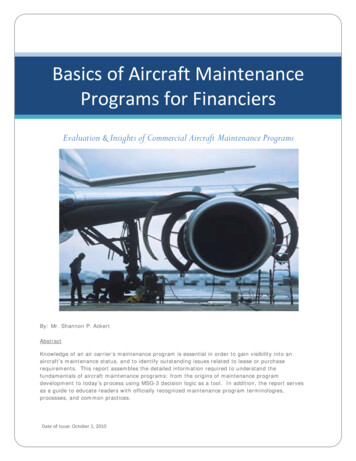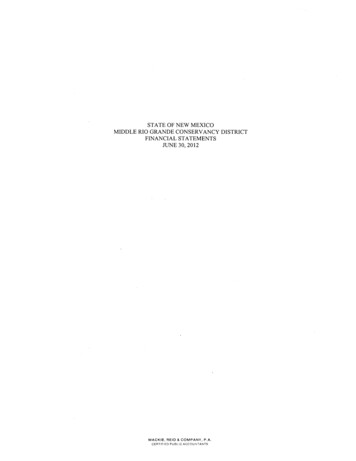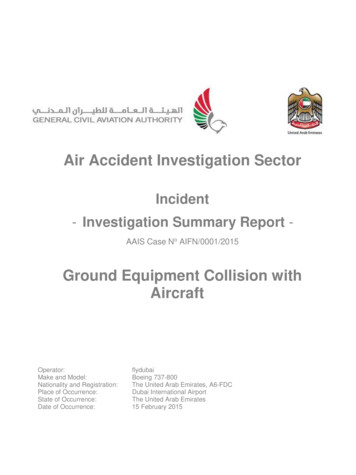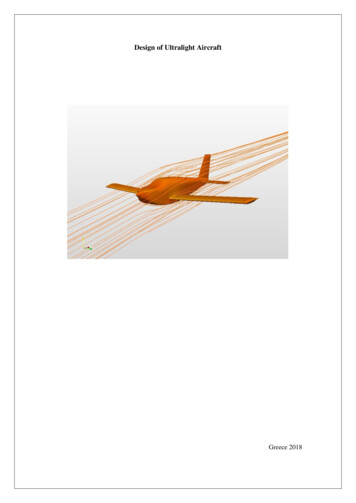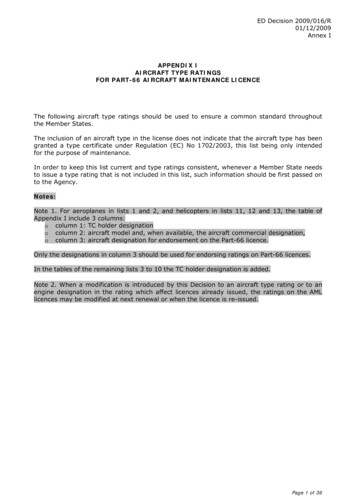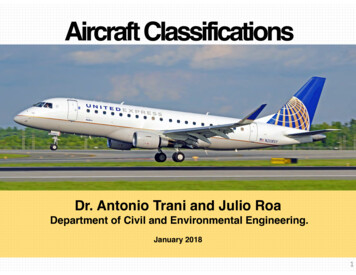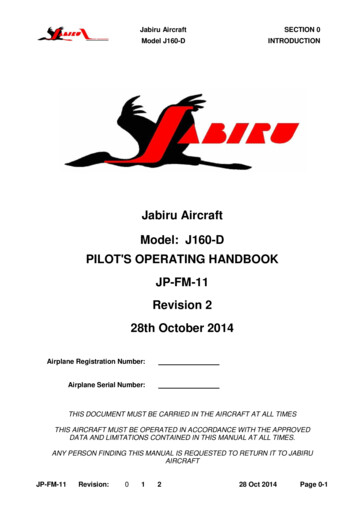
Transcription
Section/divisionForm Number: CA 12-12bOccurrence InvestigationAIRCRAFT INCIDENT REPORT AND EXECUTIVE SUMMARYReferenceAircraft RegistrationZS-PYMDate of IncidentType of AircraftBAe 146-200CA18/3/2/070719 March 2009Time of IncidentType ofOperationCommercialPilot-in-command Licence TypeAirline TransportAgePilot-in-command Flying ExperienceTotal Flying Hours9 850,037Last point of departureGeorge Aerodrome (FAGG)Next point of intended landingCape Town International Aerodrome (FACT)1210ZLicence ValidYesHours on Type633,0Location of the incident site with reference to easily defined geographical points (GPS readings if possible)On runway 19 at Cape Town International Aerodrome (FACT)Meteorological InformationNumber of people on boardWind direction 350 , wind speed 6 kts, temperature 14 C, cloud base 3 500 ft,cloud cover SCT, dew point 13 C, visibility goodNo. of people2 2 1900No. of people killedinjuredSynopsisThe aircraft was flown on a scheduled flight from Cape Town International Aerodrome (FACT) to GeorgeAerodrome (FAGG). After landing on runway 29, the flight crew experienced a no. 1 engine flame out and the no.3 engine spooled down into a hung state. Line maintenance was carried out on the aircraft to bring it back toservice. The aircraft was then flown on another scheduled flight from FAGG to FACT.After landing on runway 19 at FACT, the flight crew experienced a four-engine flame out. The initial informationindicated that the thrust modulation system (TMS) was malfunctioning. Further investigation found that during basemaintenance, the TMS was deactivated. In accordance with the manufacturer’s maintenance manual, the aircraftmaintenance organisation (AMO) was required to depower the system by pulling three primary circuit breakers todeactivate the TMS. However, it was found that the AMO had pulled a total of seven (three primary and fouractuator centering) circuit breakers. It is clear that the maintenance carried out by the AMO in this regard was notaccording to the manufacturer’s maintenance manual. The manufacturer’s maintenance manual warns that thefour actuator centering circuit breakers should not be pulled. There was a verification done in respect of the impactand influence in the event that the four actuator centering circuit breakers are pulled. The result thereof was thatthe actuators would not centre. Subsequently, during approach and landing sequence of the flight, when the flightcrew moved the throttles in the ground idle position, the actuators retracted and the power levers on the enginefuel controls moved below the ground idle position, causing the engines to spool down to sub-idle and flame out.Probable CauseAll four engines spooled down and flamed out uncommanded.Contributory remarks:The thrust modulation system (TMS) was malfunctioning.The AMO did not comply with the minimum equipment list (MEL 76-10-01) procedures, whendeactivating/reactivating the TMS. The AMO did not comply with manufacturer’s maintenance manual and otherinstructions for safe operation and continued airworthiness when carrying out maintenance on the TMS.The information of the four centering actuator circuit breakers being pulled was not written up in any of the AMOmaintenance documentation. The line stations were not aware of the centering circuit breakers being pulled.IARC DateCA 12-12bReleaseDate23 FEBRUARY 2006Page 1 of 30
Section/divisionTelephone number:Occurrence Investigation011-545-1408Form Number: CA 12-12bE-mail address of originator:thwalag@caa.co.zaAIRCRAFT INCIDENT REPORTName of tion MarksPlaceDateTime: South African Airlink (Pty) Ltd: British Aerospace: BAe 146-200: South African: ZS-PYM: Cape Town: 19 March 2009: 1210ZAll times given in this report are co-ordinated universal time (UTC) and will be denoted by (Z). South AfricanStandard Time is UTC plus two hours.Purpose of the Investigation:In terms of Regulation 12.03.1 of the Civil Aviation Regulations (1997), this report was compiled in the interests ofthe promotion of aviation safety and the reduction of the risk of aviation accidents or incidents and not toestablish legal liability.Disclaimer:This report is given without prejudice to the rights of the CAA, which are reserved.ABBREVIATIONS IN THE OAMEAMMILSDME: Air Operating Certificate: Auxiliary Power Unit: Air Traffic Controller: Air Traffic Services: Air Traffic and Navigation Services: South African Civil Aviation Authority: Civil Aviation Regulations: Airline Transport Pilot Licence: First Officer: Cockpit Voice Recorder: Digital Flight Data Recorder: Instrument Flight Rules: Aircraft Maintenance Organisation: Aircraft Maintenance Engineer (employed by AMO): Aircraft Maintenance Manual: Instrument Landing System: Distance Measuring EquipmentMEL: Minimum Equipment ListSOP: Standard Operating ProceduresACSA: Aerodromes Company of South AfricaFACT: Cape Town International AerodromeFAJSFAGGFAKN: OR Tambo International Aerodrome: George Aerodrome: Kruger Mpumalanga International AerodromeCA 12-12b23 FEBRUARY 2006Page 2 of 30
FAPHftktsMETARMHzTODPALTVHFAGMWSCDUTMSMTOPGAVDCESS BUSMCTDESCSYNCKIASN1N2N1E1N1E2N1E3N1E4TGT: Gateway Aerodrome – Phalaborwa: Feet: Knots: Meteorological Aeronautical Report: Megahertz: Top of Descent: Pressure Altitude: Very High Frequency: Attention Getter: Master Warning System: Control Display Unit: Thrust Modulation System: Maximum Take-Off Power: Go Around: Volt Direct Current: Essential Bus: Maximum Continuous Thrust: Descent: Synchronise: Knots Indicated Air Speed: Turbofan Speed (Low Compressor): Engine Spool Speed (High Compressor): N1 Engine 1: N1 Engine 2: N1 Engine 3: N1 Engine 4: Turbine Gas TemperatureMCT: Maximum Continuous Thrust1.FACTUAL INFORMATION1.1History of Flight1.1.1 On Thursday 19 March 2009 at 0507Z, a BAe 146-200 aircraft took off from CapeTown International Aerodrome (FACT) to George Aerodrome (FAGG). The flight crewflew the aircraft on a scheduled domestic flight under instrument flight rules (IFR) byday. There were 4 aircrew and 57 passengers onboard the aircraft. En route to FAGG,at 0534Z, the flight crew requested landing clearance from FAGG ATC. The first officer(F/O) was at the controls flying the aircraft. After being cleared by ATC, the F/O landedthe aircraft on runway 29 at 0550Z. When the aircraft touched down on the runway, thecaptain observed an amber attention getter (AG) annunciator light illuminated. Thecaptain then looked towards the master warning system (MWS) and saw that theamber Elect was on and that the number one generator was inoperative. Shortlythereafter, a red AG annunciator light illuminated, due to theno. 1 engine flaming out. When the captain saw what was happening, he immediatelytook over control of the aircraft and completed the landing. The aircraft airspeed was 80 KIAS at the time. After taking over control, the captain observed that the red andamber AG annunciator lights were still illuminating. At this time, theCA 12-12b23 FEBRUARY 2006Page 3 of 30
no. 3 engine also started to spool down into a hung state, though it did not flame out.The captain observed the following readings for no. 3 engine on the instruments: theN2 gauge indicated 20% (it is normally at 50% ground idle); the N1 was just under20% (it is normally 20%); the TGT was slightly lower than the other engines; the red OilPress caption illuminated and the oil pressure gauge indicated a low oil pressure.1.1.2 When the aircraft was vacating the runway, the F/O took the Abnormal and EmergencyChecklists and started to action the low oil pressure emergency procedure checklist onthe no. 3 engine and the flame out emergency procedure checklist on theno. 1 engine. On the apron, the flight crew executed a normal engine shutdown on theno. 2 and no. 4 engines. When the cabin doors were opened, the passengersdisembarked normally from the aircraft without incident. The flight crew remainedseated inside the aircraft, assessing and attempting to determine the cause of theengine flame out. Both pilots’ attention was drawn to the thrust modulation system(TMS) and they observed blue arrow annunciator lights illuminating for the no. 1 andno. 3 engines. The flight crew found the fact that the blue arrow annunciator lights wereilluminating strange, because normally all the lights on the TMS are off when thesystem is not energised and switched off.1.1.3 The flight crew reported the defect to the operator line station at FAGG, who consultedwith main base at FAJS for input into the rectification action. Following theconsultations, line maintenance work was done on the aircraft. After the maintenancewas completed, the flight crew performed engine ground runs to satisfy themselves ofthe serviceability status. All four engines started normally and the engine runs weredone up to maximum take-off power (MTOP) without experiencing any furtherabnormalities. The captain ran the engines up to MTOP and to idle with the TMSswitched on and off. All systems seemed to be fine and operating as required. Thecaptain also simulated an approach and landing scenario, by running the engines up toMTOP and selecting the TMS to synchronise but at the same time also retarding thethrust levers. The TMS was assessed as operating normally. The captain duplicatedthe procedure with all four engines and then with the no. 1 and no. 3 engines separately. Everything appeared to be acceptable. On completion of theline maintenance work, the aircraft was certified serviceable and released to service.1.1.4 For the return flight to FACT, 19 passengers were taken on board the aircraft.At 0727Z, the aircraft departed from FAGG to FACT on a scheduled domestic IFR flightby day. The captain was at the controls and flying the aircraft. En route to FACT, thecaptain observed that the TMS for the no. 2 engine was not functioning correctly. Whenthe aircraft was flying in the downwind sector of the landing approach to Cape Town,the throttles were set to flight idle. The captain observed that the no. 2 engine speedwas at 50% (which is approximately the ground idle for the engines) and that theother three engines were operating normally at 60%. A visual approach was executedto land on runway 19. During the landing, the captain observed the red and amber AGannunciator lights illuminating again. Shortly after touchdown, with the throttles set atground idle, the aircraft experienced an all-four-engine spool down and flame out. Thecaptain gave instructions to the F/O to notify FACT ATC of the engine flame outsituation. The aircraft had enough momentum to roll forward on the runway and vacateonto taxiway Charlie. The auxiliary power unit (APU) was still operating and gaveelectrical power to the hydraulic system, which enabled the captain to apply necessarybrakes to steer the aircraft from the runway safely.1.1.5 When the aircraft was stationary on the taxiway, the captain contacted themaintenance personnel at the FACT line station and was advised to restart the enginesand to taxi the aircraft to the apron. The captain restarted the engines and saw themCA 12-12b23 FEBRUARY 2006Page 4 of 30
spooling up to 17% only. According to the captain, it appeared as though there was nofuel flow to the engines. The aircraft was then towed from the taxiway to the apronarea. After the cabin doors were opened, the passengers disembarked normally fromthe aircraft without incident. The flight crew remained seated in the cockpit during thedisembarkation of the passengers and observed that the two blue arrow annunciatorlights were illuminating on the TMS again.The aircraft did not sustain any damage and there was no injury to the occupants.FACT :RWY 01/19Landing: RWY 19BAe 146-200 stoppedon taxiway Charlie C.Aircraft type: BAe 146-200Figure 1: Cape Town Int. Aerodrome (FACT), runway 19landing direction and taxiway C1.2Injuries to Pass.19Other-Damage to AircraftCA 12-12b23 FEBRUARY 2006Page 5 of 30
1.3.1 The aircraft did not sustain any damage in the incident.1.4Other Damage1.4.1 There was no other damage.1.5Personnel Information1.5.1 Captain:NationalityLicence NumberLicence ValidRatingsMedical Expiry DateRestrictionsPrevious AccidentsSouth AfricanGender Malexxxxxxxxxxxxx Licence TypeYesType EndorsedInstrument; Night31 January 2010NoneNoneAge 37Airline TransportYes1.5.2 Flying experience:Total HoursTotal Past 90 DaysTotal on Type Past 90 DaysTotal on Type9 850.0110.092.0633.01.5.3 The captain completed training on the aircraft type on 31 May 2008. He submitted anapplication for issuance of a type rating to the SACAA on 2 June 2008. Complying withregulatory training requirements, the pilot also submitted proof of training informationthat indicated that he flew a total of 33.3 hours on the type. The SACAA reviewed hisapplication and issued the type rating on 03 June 2008.1.5.4 According to the operator, the captain’s flight and on-duty times for the previous 48hours were as follows:1.5.4.1The captain reported for duty on 18 March 2009 at 1100Z and was on duty until2053Z. According to the information given on the Crew Roster Report, the captainaccumulated 06:59 flight time and 09:53 duty time. The following day,19 March 2009, he accumulated another 1:58 hours flight time and 04:34 hoursduty time.1.5.5 According to the captain, the F/O flew the aircraft to FAGG. The captain took overcontrol of the aircraft during landing when they experienced the engine flame-outincident. On the flight back to FACT, the captain flew the aircraft.1.5.6 First officer:NationalityLicence NumberLicence ValidRatingsMedical Expiry DateCA 12-12bSouth AfricanGender MaleAge 27xxxxxxxxxxxxx Licence TypeCommercialYesType Endorsed YesInstructor Grade 2, Flight Tests, Instrument; Night30 June 200923 FEBRUARY 2006Page 6 of 30
RestrictionsPrevious AccidentsNoneNone1.5.7 Flying experience:Total HoursTotal Past 90 DaysTotal on Type Past 90 DaysTotal on Type3 033.8157.1150.31 123.61.5.8 The F/O completed training on the aircraft type on 16 May 2007. He submitted anapplication for issuance of the type rating to the SACAA on 18 May 2007. Complyingwith regulatory training requirements, he submitted proof of training information thatindicated a total of 37.6 hours on the type. The SACAA reviewed the application andissued the type rating on 18 May 2007.1.5.9 According to the operator, the F/O’s flight and on-duty times for the previous 48 hourswere as follows:1.5.9.1The F/O was on duty on 18 March 2009 from 1106Z to 2053Z. According to theinformation given on the Crew Roster Report, the F?O accumulated 06:59 hoursflight time and 09:46 hours duty time. The next day, 19 March 2009, heaccumulated another 1:58 hours flight time and 13:05 hours duty time. There wasno anomaly identified with the flight on duty time of the flight crew.Cabin Crew Members:1.5.101.5.10.1In-command flight attendant (ICFA):NationalityLicence NumberLicence Valid1.5.10.2South AfricanxxxxxxxxxxxxxYesGender MaleLicence TypeType EndorsedAgeCabin CrewYes30South AfricanxxxxxxxxxxxxxYesGender FemaleAgeLicence TypeCabin CrewType Endorsed Yes22Flight attendant:NationalityLicence NumberLicence Valid1.5.11 Both flight attendants were found to be appropriately qualified, experienced and ratedon the aircraft type. The performances of the flight attendants were professional andthere was no proof of any anomaly identified with their cabin duties on the day.1.5.12 According to the operator, the flight and on-duty times of the flight attendants for theprevious 48 hours were as follows:1.5.12.1 The flight attendants started work on 18 March 2009 at 0909Z and worked to1853Z. According to the information given on the Crew Roster Report, the flightattendants accumulated 06:59 hours flight time and 09:46 hours duty time. The nextday, on 19 March 2009, they accumulated another 1:58 hours flight time and 07:05hours duty time. There was no anomaly identified with the flight on-duty times of theflight attendants.CA 12-12b23 FEBRUARY 2006Page 7 of 30
1.6Aircraft Information1.6.1 Airframe:TypeSerial No.ManufacturerDate of ManufactureTotal Airframe Hours & Cycles(At Time of Incident)Last Phase Inspection(Date, Hours & Cycles)Hours & Cycles Since Last PhaseInspectionC of A (Issue Date)C of R (Issue Date) (Present Owner)Operating CategoriesBAe 146-200E-2058British Aerospace198633 335.73 hours33 672 cycles13 February 200933 227 hours33 566 cycles108.73 hours106 cycles29 November 200703 April 2008South African Airlink (Pty) Ltd.Standard1.6.2 Engine no. 1TypeSerial No.Hours & Cycles Since New(HSN & CSN)Cycles Since Hot Section Inspection(CSHSI)1.6.3 Engine no. 2TypeSerial No.Hours & Cycles Since New(HSN & CSN)Cycles Since Hot Section Inspection(CSHSI)Honeywell ALF 502 R-5LF 05145 AC27 606.72 hours28 383 cycles3 097 cyclesHoneywell ALF 502 R-5LF 05604 AC26 623.24 hours24 626 cycles3 987 cycles1.6.4 Engine no. 3TypeSerial No.Hours & Cycles Since New(HSN & CSN)Cycles Since Hot Section Inspection(CSHSI)CA 12-12bHoneywell ALF 502 R-5LF 05185 AC28 493.25 hours28 105 cycles3 773 cycles23 FEBRUARY 2006Page 8 of 30
1.6.5 Engine no. 4TypeSerial No.Hours & Cycles Since New(HSN & CSN)Cycles Since Hot Section Inspection(CSHSI)Honeywell ALF 502 R-5LF 05231AC28 135.15 hours28 872 cycles690 cycles1.6.6 Fuel:The aircraft was refuelled at Cape Town with Jet A-1 on 19 March 2009. The fueluplifted was total of 4 790 l (1 265.384 US gal). After refuelling the aircraft, the total fuelcapacity was 7 500 l (1 981.29 US gal). According to the captain, at the time when theyexperienced the incident at FAGG there was a total of 5 700 l(1 505.78 US gal) fuel in the aircraft. At Cape Town when they experienced the secondincident, the total fuel carried onboard was 3 300 l (871.76 US gal). There was noanomaly identified with fuel status.1.6.7 Mass and balance:1.6.7.1The masses relevant to the take-off and landing were as follows:Zero Fuel WeightTake-off Fuel WeightActual Take-off WeightTrip Fuel (Burn-off)Taxi FuelCorrectionsActual Landing WeightMaximum Allowable Take-off Weight(MTOW)Maximum Allowable Landing Weight26 300 kg5 000 kg31 100 kg-1 800 kg-200 kg-100 kg29 200 kg42 184 kg36 740 kg1.6.7.2The calculated actual take-off weight was 31 100 kg, indicating that the aircraft was11 084 kg below the maximum take-off weight of 42 184 kg. The aircraft burned off1 800 kg of fuel after take-off and landed with an actual landing weight of 29 200kg, which was 7 540 kg below the maximum landing weight for the aircraft.1.6.7.3The mass and balance of the aircraft was found to be within limits and did notcontribute to the cause of the incident.1.6.8 Maintenance:1.6.8.1According to the flight crew, the two incidents of the engine flame-outs wereassociated with the TMS malfunctioning, and that this malfunctioning could berelated to a component or systems defect/malfunctioning. To verify if there was anyevidence of this defect re-occurring, the maintenance records of the aircraft werereviewed with specific emphasis on determining if there were any entries made ofdeferred defects of the TMS.1.6.8.2Maintenance records indicated that the TMS was reported to be faulty on17 March 2009, prior to a scheduled flight to Kruger Mpumalanga InternationalCA 12-12b23 FEBRUARY 2006Page 9 of 30
Aerodrome (FAKN). The flight crew reported the defect of the TMS to the AMO.According to the AMO, the TMS defect was investigated, and they took a decisionto defer the defect and then deactivate the TMS. The aircraft was released toservice under MEL ATA 76-10-1 conditions.1.6.8.3According to the MEL, the TMS may be inoperative provided that:(i) All four actuators are centered,(ii) The system is depowered by pulling and collaring the primary circuit breakers,and(iii) The actuating centering circuit breakers must NOT be pulled.1.6.8.4When the method of compliance with the MEL requirements was investigated, itwas found that the AMO had not complied with the identified MEL conditions in that:(i) The AMO did not follow the correct maintenance procedure in ensuring that allfour actuators were centered, prior to deactivating the system.(ii) Instead of pulling and collaring only the primary circuit breakers, the AMO alsopulled the actuator centering circuit breakers.(iii) The collaring of the circuit breakers was done with black tie raps.1.6.9 The aircraft was then flown for two flights (FAJS to FAKN, FACT to FAGG and FACT)with the TMS deactivated on the 17 March 2009. After the last flight to FACT, the linestation installed two components (a TMC and a control display unit [CDU]) on theincident aircraft, which had been removed from another aircraft. After the componentswere installed, the system was reactivated and aircraft certified serviceable. Thedeferred defect was then cleared and MEL 76-10-1 exceptions were no longerapplicable.1.6.10 It was found that during the reactivation of the system, the AMO only reset the primarycircuit breakers. The other four actuator centering circuit breakers were not reset. Theaircraft was released to service with this potentially unsafe condition.1.6.11 On 18 March 2009, the aircraft flew six scheduled flights (FACT to FAGG, FAGG toFACT, FACT to FAKN, FAKN to FACT, FACT to FAGG and FAGG to FACT). Therewere no further TMS defects reported on the day.1.6.12 On 19 March 2009, the aircraft was flown again from FACT to FAGG and back.According to the information in the aircraft technical log, after landing at FAGG, theflight crew reported an incident of where the no. 1 engine had flamed out and theno. 3 engine spooled down to a hung state. This was associated with the blue arrowwarning lights illuminating on the CDU as observed by the flight crew. The AMO LineStation carried out an engine flame-out troubleshooting inspection as described above.On completion of the inspections and maintenance, the defect was closed with an entryin the technical log recording the rectification action as follows:CA 12-12b23 FEBRUARY 2006Page 10 of 30
Note: All systems were shut down and powered up again. Engine runs carried outwith and without TMS operative. All parameters were normal. Fuel and Oil filtersbypass valves were checked and found normal.1.6.13 When the above maintenance was carried out, the maintenance personnel involvedwere not aware of the actuator circuit breakers having being pulled. According to thepersonnel, they conducted a visual check of the circuit breakers panel for circuitbreakers that tripped. All circuit breakers that they looked at were in normal pushed-inposition. On completion of the maintenance, all relevant information of the activitiesfollowed was forwarded to the AMO.1.6.14 The aircraft was certified serviceable and flown from FAGG to FACT with the TMSreactivated. When the aircraft landed at FACT, all four engines flamed out. Accordingto the record of information in the aircraft technical log, the no. 2 engine TMS bluearrow down warning light was illuminating and flashed continuously. This conditionhappened even in synchronise (SYNC) mode, irrespective of which engine was themaster and position of the thrust lever. The blue arrow warning lights were flashing withdown - and up - indications.1.6.15 After the incident happened at FACT, troubleshooting inspection was carried out on theaircraft. It was established that the TMS was not functioning correctly and as a resultcaused all four engines to flame out. The AMO proceeded with maintenanceprocedures to determine which of the TMS components were at fault. The TMC wasidentified as being one of the components that was malfunctioning. In their process ofelimination, the AMO removed and installed between aircraft the two componentsnamely the TMC, part no. 2117578-9, serial no. 85-263; and the CDU, part no.2117576-3, serial no. 18-281.1.6.16 After maintenance was carried out on the aircraft at Cape Town, the TMS wastemporarily deactivated. The aircraft was then operated under MEL conditions. Onlywhen referring to the four actuator centering circuit breakers did the AMO discover theanomaly of the four actuator circuit breakers being pulled.1.7Meteorological InformationWind DirectionTemperatureDew Point350 14 C13 CWind SpeedCloud Cover6 ktsSCTVisibilityCloud BaseGood3 500 ft1.7.1 The above weather information was submitted by the captain in a PilotAccident/Incident Questionnaire.1.8Aids to Navigation1.8.1 The aircraft was flown under IFR by day. The flight crew landed at FACT onrunway 19. The following radio navigation and landing aids were available at FACT:(i)(ii)(iii)CA 12-12bnon-directional radio beacon (NDB), CB: frequency 462.5 kHzvery high frequency omnidirectional radio range (VOR), CTV: frequency115.7 MHzdistance measuring equipment (DME), CTV/CTI/KSI: frequencies 1191 MHz,110.3 MHz and 109.1 MHz23 FEBRUARY 2006Page 11 of 30
(iv)(v)(vi)instrument landing system (ILS), LOC: frequency 109.1 MHzinstrument landing system (ILS), GP CATII: frequency 331.4 MHzrunway centrelines and identification markings1.8.2 All the above identified navigation and landing aids were serviceable and under24-hours operation.1.8.3 The navigational equipment found installed in the aircraft was as per approved MEL.There was no report of the flight crew experiencing any anomalies with the aircraftnavigation equipment.1.9Communications1.9.1 George Aerodrome (FAGG):1.9.1.1The Air Traffic Services (ATS) communication facilities available at FAGG areTower/Approach (118.9 MHz) and Apron (122.65 MHz). There was no proof of anyanomaly experienced with the ATS communication facilities at the Aerodrome.1.9.1.2According to FAGG ATC, the aircraft was cleared for ILS approach on runway 26.The ATC did not receive any transmissions on 118.9 MHz or 121.5 MHz to reportany abnormality. The flight crew contacted the tower from the apron approximately20 to 30 minutes after the landing, requesting clearance to do engine run-ups. TheATC gave instructions to taxi to the threshold of runway 20 for engine run-ups.1.9.2 After the passengers boarded the aircraft at FAGG, it was cleared for take-off for theflight back to FACT.1.9.3 Cape Town Int. Aerodrome:1.9.3.1The ATS communication facilities available at FACT are Control (125,1 MHz),Information (126,5 MHz), Approach (119,7 MHz), Tower (118,1 MHz) and Ground(121,9 MHz). The communication facilities are available 24 hours a day. There wasno record of any anomaly experienced with the ATS communication facilities.1.9.3.2According to the ATC, the incident was reported to the tower immediately after ithad happened. After the flight crew confirmed the status of the aircraft, the flightcrew were given instructions to exit the runway into taxiway C (Charlie). The ATCthen also activated the crash alarm for the fire and rescue services to dispatch tothe incident site. The aircraft was safely recovered to the apron.1.9.4 The aircraft had VHF transmitter radio equipment installed (2 x Collins 618M-5).In addition to the VHF radio equipment, the flight crew could communicate with theATC by means of microphone, to cabin crew by means of passenger assist (PA) andthe passengers by means of an aircraft intercom system. There was no record of anyanomaly experienced with the aircraft communication equipment on the day.CA 12-12b23 FEBRUARY 2006Page 12 of 30
1.9.5 Flight crew communication:1.9.5.1According to the captain, at the time when they experienced the incident at FAGG,he did not deem it necessary to inform ATC of the engine flame-out incident, asthey were occupied with a relatively high workload in the cockpit, and didn’t requireany assistance from ATC or the emergency services. The captain did not think thatit would be a problem, as ATC was not in any way involved in the incident.1.9.5.2The communication at FACT was explained as follows: The captain instructed theF/O to notify the ATC of the incident. Once the F/O was finished talking to ATC, hewas then instructed to contact another operator’s control office to ask them tocontact their engineers to bring out a tug to tow the aircraft to the apron.1.9.5.3When the aircraft was stationary on taxiway C, the captain phoned their operatorduty engineer to follow up on their earlier request for a tug to tow the aircraft. In theconversation, the captain was given instructions by the engineer to start up theengines and to taxi the aircraft to the apron. The captain hesitated at first out of fearthat he might cause damage to the engines. The engineer initially agreed but a fewminutes later confirmed that the instructions were supported by the main base atFAJS. The captain was unsuccessful with the start-up and only then did theengineer volunteer to bring the tug to tow the aircraft from the taxiway to the apron.1.9.6 Flight attendants communication: During the flight to FAGG and FACT, everything wentas normal until the landing. The flight attendants were informed by the captain of theincident and requested to keep the passengers calm, seated and that the aircraft wouldbe towed to the apron. In both incidents, the passengers disembarked from the aircraftnormally without sustaining any injury.1.10Aerodrome Information1.10.1 Departure aerodrome:Aerodrome LocationAerodrome Co-ordinatesAerodrome ElevationRunway DesignationsRunway DimensionsRunway UsedRunway SurfaceApproach FacilitiesGeorge Aerodrome (FAGG)S34º00’.24.1” E022º22’.27.4”648 ft11/2902/202 000 x 451 160 x 3029ASPHNDB, ILS, DME1.10.2 Arrival aerodrome:Aerodrome LocationAerodrome Co-ordinatesAerodrome ElevationRunway DesignationsRunway DimensionsRunway UsedRunway SurfaceApproach FacilitiesCA 12-12bCape Town InternationalAerodrome (FACT)S33º58’05.3” E018º36’16.7”151 ft01/1916/343 201 x 611 701 x 4619ASPHNDB, ILS, DME, VOR23 FEBRUARY 2006Page 13 of 30
1.11Flight Recorders1.11.1 The Flight Recorders installed on the aircraft were the following:(i)The flight data recorder (FDR) that was installed in the aircraft was a Plesseytype, part no. 650/1/14040/209, seri
CA 12-12b 23 FEBRUARY 2006 Page 2 of 30 Section/division Occurrence Investigation Form Number: CA 12-12b Telephone number: 011-545-1408 E-mail address of originator: thwalag@caa.co.za AIRCRAFT INCIDENT REPORT Name of Owner/operator : South African Airlink (Pty) Ltd Manufacturer : British Aerospace Model : BAe 146-200 Nationality : South African
